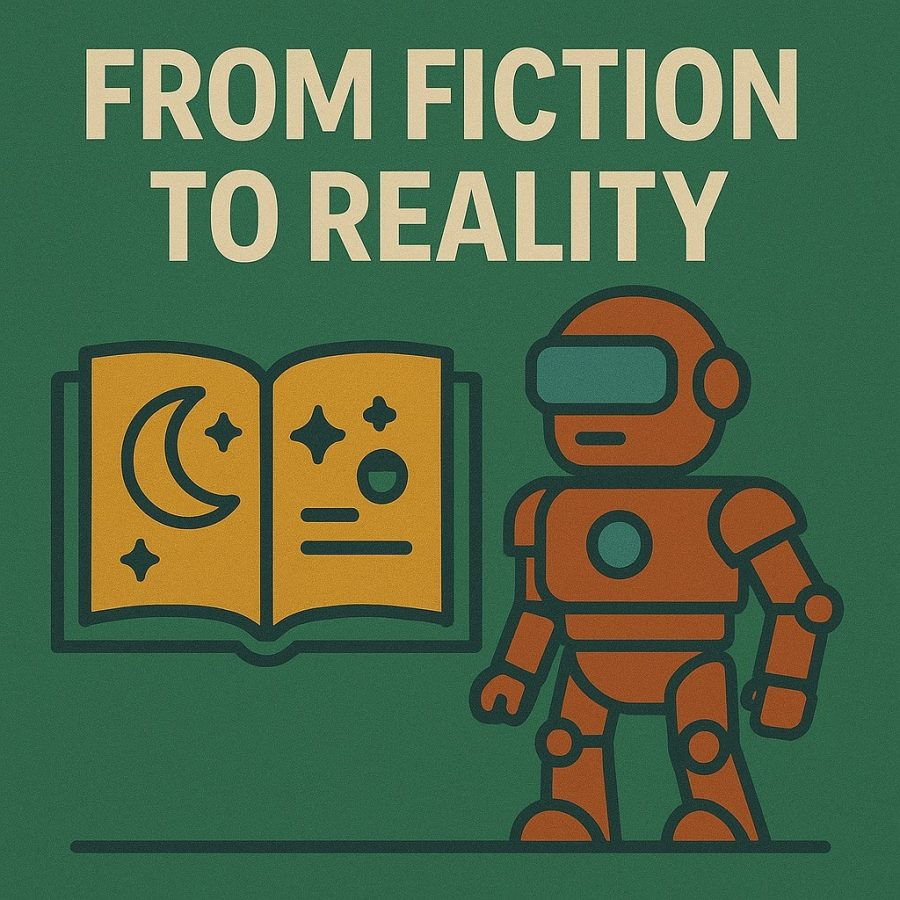Views: 0
Science fiction once lived in the margins of imagination. Writers dreamed up talking machines, robotic helpers, and computers that could reason like people. For decades, these visions felt like entertainment rather than possibility. Yet here we are in 2025, with From Fiction to Reality: AI Concepts That Became Real no longer a catchy book title but a genuine description of our world.
The transformation is staggering. Artificial intelligence has moved from pulp magazines to boardrooms, from cinematic villains to smartphone assistants, and from speculative futures to products you can order online today. This article explores the key concepts once written as fiction that are now everyday realities, tracing their origins, cultural impact, and the ways they shape our lives.
Why Fiction and AI Always Intertwined
Fiction has always been a test lab for technology. Before AI had working prototypes, authors like Isaac Asimov and Arthur C. Clarke seeded ideas of robots with rules, computers with emotions, and networks that outthink humans. Film added personality, think HAL 9000 from 2001: A Space Odyssey or R2-D2 from Star Wars.
These fictional concepts did more than entertain. They created blueprints. Researchers inspired by these stories often pursued real-life equivalents. When a computer scientist designs a conversational agent, they are often chasing the dream of building “C-3PO for real.”
The cycle works like this: fiction imagines, engineers prototype, culture adapts, and the line between invention and story blurs.
Conversational AI: Talking Machines Become Common
One of the clearest From Fiction to Reality: AI Concepts That Became Real examples is conversational AI.
Fictional Origins
Science fiction gave us countless talking machines: HAL’s calm menace, Star Trek’s computer answering in clipped precision, or Jarvis guiding Iron Man through his missions. For decades, talking with a machine was a fantasy.
Reality Today
Siri, Alexa, Google Assistant, and ChatGPT turned the fantasy into daily routine. Millions now casually ask AI to set timers, draft messages, or recommend playlists. GPT-4o, capable of real-time conversation, brings us closer to natural dialogue where machines listen, adapt, and even joke.
The dream of conversing with technology is not only achieved, it is so normal that toddlers now grow up speaking to AI as if it were a family member.
Predictive Policing and Surveillance: Minority Report Made Real
Fictional Origins
Philip K. Dick’s Minority Report introduced the idea of predicting crimes before they happen. While precogs do not exist, the concept of data-driven preemptive justice resonated.
Reality Today
Modern police departments use predictive algorithms to identify crime “hotspots” or flag individuals as potential risks. Facial recognition systems monitor public areas, raising both efficiency and ethical alarms. While no one is arrested for crimes they have not committed, the From Fiction to Reality: AI Concepts That Became Real story here is about how predictive analytics have moved from Hollywood to precincts.
The controversy is significant: proponents argue it reduces crime, critics argue it enforces bias and undermines privacy.
Autonomous Vehicles: Self-Driving Dreams
Fictional Origins
From Knight Rider’s KITT to futuristic hovercars, autonomous vehicles were a sci-fi staple. They promised freedom from steering wheels and traffic jams.
Reality Today
Tesla, Waymo, Cruise, and other firms now field fleets of cars that navigate city streets without human hands. Semi-autonomous features like autopilot, adaptive cruise control, and lane assistance are already standard in many cars.
Full autonomy still struggles with edge cases like bad weather and unpredictable pedestrians, but the shift is undeniable. When a child born today reaches adulthood, the idea of driving manually may feel as quaint as winding up a wristwatch.
Healthcare AI: Star Trek’s Medical Tricorder Comes Alive
Fictional Origins
Star Trek famously introduced the tricorder, a handheld device that could diagnose conditions instantly. Fiction long promised medical assistants capable of spotting disease earlier than human doctors.
Reality Today
AI diagnostic tools are now approved by medical boards worldwide. Algorithms detect cancer in scans, identify heart irregularities, and even diagnose rare genetic conditions. Chatbots triage patient questions before human doctors step in. Wearables track blood oxygen and heart rates, effectively serving as miniature tricorders on our wrists.
In the From Fiction to Reality: AI Concepts That Became Real arc. Healthcare is one of the most impactful domains, literally saving lives once only saved in novels.
Referee Bots: Sports Science Fiction in Practice
Fictional Origins
Sports fiction often teased the idea of perfect referees, unblinking and unbiased, unlike human officials prone to error.
Reality Today
Tennis now uses Hawk-Eye AI to determine line calls with millimeter accuracy, replacing line judges at top tournaments. Baseball is piloting AI strike zones, where a digital umpire rules balls and strikes. Soccer experiments with semi-automated offsides.
The controversial part is fan psychology: some argue that human error is part of sports drama. Still, the From Fiction to Reality: AI Concepts That Became Real narrative shows that fairness is winning out, one bot call at a time.
Personal Companions: Sci-Fi’s Talking Friends
Fictional Origins
From Her’s Samantha to Blade Runner’s Joi, fiction envisioned AI as companions—sometimes assistants, sometimes friends, sometimes more.
Reality Today
Replika, Pi, and other AI companion apps already simulate friendships and emotional exchanges. ChatGPT and similar systems can remember conversations, shaping themselves to a user’s preferences. Robotics companies have launched social robots like Pepper and ElliQ for elderly companionship.
What once was cinematic speculation is now daily comfort for people seeking connection. This From Fiction to Reality: AI Concepts That Became Real development also stirs debate about loneliness, authenticity, and the boundaries of love.
Smart Homes: Living Like The Jetsons
Fictional Origins
The Jetsons’ cartoon family lived in a house filled with automated gadgets and robotic helpers. Doors opened automatically, kitchens cooked on command, and every room responded to voice control.
Reality Today
Smart speakers, connected thermostats, AI-powered security cameras, and robotic vacuum cleaners have made the Jetsons lifestyle familiar. In many homes, you can dim lights, order groceries, and lock doors with a single voice command.
The modern home may not have Rosie the Robot yet, but the From Fiction to Reality: AI Concepts That Became Real story is clear. Our dwellings are now living entities of their own.
Creative AI: Machines That Write, Paint, and Compose
Fictional Origins
Fiction has long questioned whether machines could create art. Stories speculated on robots writing poetry or androids painting masterpieces.
Reality Today
AI image generators like MidJourney and DALL·E create stunning artwork in seconds. Language models draft essays, novels, and marketing campaigns. Music AIs compose symphonies tailored to moods.
The creativity frontier once considered uniquely human is now crowded with algorithms producing content at scale. Whether you call it art or output, the From Fiction to Reality: AI Concepts That Became Real point is undeniable, machines can create.
Military AI: Fiction’s Darkest Predictions
Fictional Origins
From killer robots in Terminator to autonomous drones in Ender’s Game, fiction repeatedly warned of AI weapons.
Reality Today
Autonomous drones already patrol skies, capable of targeting without direct human input. Military simulations use AI to plan campaigns. Cyber defense systems respond automatically to attacks.
While no global Skynet exists, militaries increasingly rely on AI to extend reach and efficiency. The ethical dilemmas are intense, making this one of the most worrying examples of fiction bleeding into reality.
Education and AI Tutors
Fictional Origins
Teachers powered by holograms or robot instructors appeared in countless sci-fi futures. Personalized learning with machine tutors was a dream.
Reality Today
AI tutors now help students solve math, write essays, and learn languages with adaptive precision. Apps powered by large language models tailor content to a student’s pace and style. Universities deploy chatbots for administrative support and teaching reinforcement.
The From Fiction to Reality: AI Concepts That Became Real trajectory in education is positive: more access, less cost, and potentially more equity in global learning.
Everyday Translation: The Babel Fish Arrives
Fictional Origins
Douglas Adams introduced the Babel Fish in The Hitchhiker’s Guide to the Galaxy—a tiny creature that instantly translated any language.
Reality Today
AI translation tools like Google Translate and DeepL have achieved real-time translation across dozens of languages. Earbuds powered by AI offer live interpretation, letting two people speak seamlessly across linguistic divides.
For travelers and global businesses, this is one of the most dramatic cases of fiction landing in reality.
Table: Fictional Concepts vs Real AI
| Fictional Concept | Original Inspiration | Current Reality |
| Talking Computers | Star Trek, HAL 9000 | Siri, Alexa, ChatGPT |
| Predictive Crime | Minority Report | Predictive policing algorithms |
| Autonomous Cars | Knight Rider | Tesla, Waymo |
| Medical Tricorder | Star Trek | Wearables, AI diagnostics |
| Perfect Referees | Sports fiction | Hawk-Eye, AI strike zones |
| AI Companions | Her, Blade Runner | Replika, Pi AI, ElliQ |
| Smart Homes | The Jetsons | Smart speakers, IoT devices |
| Robot Artists | Sci-fi literature | MidJourney, DALL·E |
| Killer Machines | Terminator | Military drones |
| AI Teachers | Futuristic schools in fiction | Adaptive AI tutors |
| Babel Fish | Hitchhiker’s Guide | Google Translate, AI earbuds |
The Cultural Shift: When Fiction Stops Being Fiction
When a technology becomes so commonplace that we forget it was once science fiction, culture shifts. Few people marvel at Siri today, yet in 1980, the very idea of a voice-activated assistant was considered magic.
This cultural forgetting is what makes From Fiction to Reality: AI Concepts That Became Real profound. We live inside yesterday’s science fiction without pausing to appreciate the journey.
The Future: Which Fiction Will Be Next?
If history is our guide, more fictional AI concepts will leap into reality. Potential candidates:
- Brain-Computer Interfaces — inspired by Neuromancer, with Elon Musk’s Neuralink already in trials.
- Full AI Athletes — fictional android competitors may evolve into real robotic sports leagues.
- AI Governments — novels about machine-led councils could inspire data-driven governance.
- Synthetic Consciousness — fiction’s dream of self-aware AI remains on the horizon.
The cycle will not end. As long as imagination exists, engineers will chase it.
Conclusion
The journey of From Fiction to Reality: AI Concepts That Became Real proves something important. Fiction does not just predict technology it invites it. Writers spark visions. Engineers bring them into being. Culture then absorbs them until they feel normal.
The talking computer, the predicting machine, the robotic umpire, the AI artist. All were once speculative dreams. Today they are news headlines, phone apps, and household devices. Tomorrow, today’s wildest stories will follow the same path.
The only question is which piece of science fiction will be the next to quietly step into your living room and make you forget it was once fantasy.


](https://altpenguin.com/wp-content/uploads/2025/08/veed-ad.webp)

